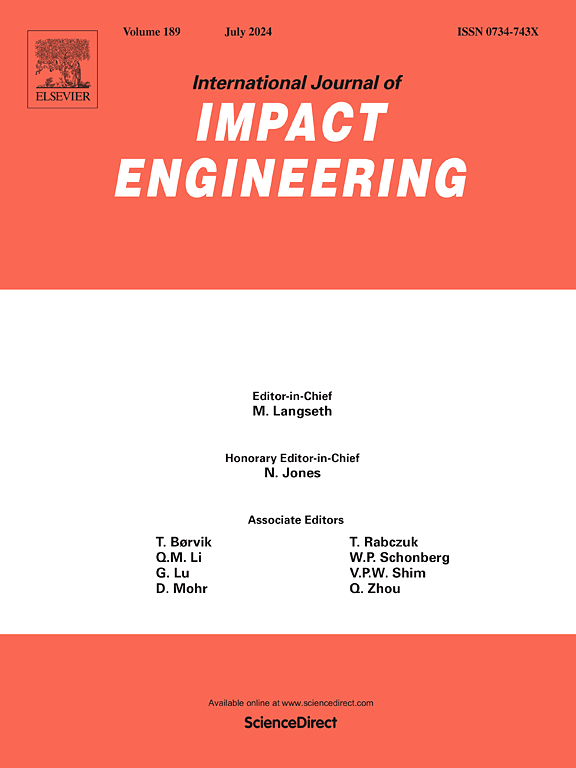岩石弹丸与金属靶间超高速撞击弹丸抛射物的空间和形状分布
IF 5.1
2区 工程技术
Q1 ENGINEERING, MECHANICAL
International Journal of Impact Engineering
Pub Date : 2025-02-07
DOI:10.1016/j.ijimpeng.2025.105252
引用次数: 0
摘要
在大约3 ~ 7 km/s的速度范围内,对岩石弹丸和钢靶进行了超高速撞击实验。用铝箔靶分析了不同弹射角度下的弹射效果。在25°至50°范围内,相对于本研究检测的弹丸轨迹,弹丸数密度在50°处最高。在前人研究的基础上,利用新建立的经验关系式,从箔孔的相应轴线上估计出喷射物的长、短轴。在3 km/s和5 km/s速度下,弹射轴比分布与弹射角的关系不明显。当撞击速度为7km /s时,抛射物的轴向比趋于高于较低撞击速度时的轴向比。喷射物的轴比分布与尺寸有关,与3 km/s或5 km/s的撞击速度相比,7 km/s的喷射物中轴比较小的喷射物部分被抑制,这可能是由于包含具有高轴比的熔体液滴。另一方面,在较大尺寸范围内(>20µm)的抛射物与冲击速度的轴比分布没有变化,表明该尺寸的抛射物可能是固体碎片。对气凝胶块中捕获的喷射物的观察显示,尺寸从几微米到10微米不等的球形结构可能是熔融液滴。该模型考虑了熔体的动能和表面能之间的平衡,其大小与先前的物理模型预测的大小相同。本文章由计算机程序翻译,如有差异,请以英文原文为准。
Spatial and shape distributions of ejecta from hypervelocity impact between rock projectile and metal target
Hypervelocity impact experiments of rock projectiles and steel targets were conducted at velocities ranging from approximately 3 km/s to 7 km/s. Ejecta with various ejection angles were analyzed using aluminum foil targets. The number density of ejecta was highest at 50° within the range of 25° to 50° relative to the projectile trajectory examined in this study. The major and minor axes of the ejecta were estimated from the corresponding axes of the foil holes, using an empirical relationship newly formulated in this study based on a previous study. No clear dependence of the ejecta axial ratio distributions on ejection angle was observed for impacts at 3 km/s and 5 km/s. For impacts at 7 km/s, the axial ratio of the ejecta tended to be higher than that observed at lower impact velocities. The axial ratio distribution of the ejecta exhibited a dependence on size, with the fraction of ejecta smaller than 10 µm having small axial ratios being suppressed at an impact velocity of 7 km/s compared to 3 km/s or 5 km/s, likely due to the inclusion of melt droplets that would have high axial ratios. On the other hand, ejecta in the larger size range (>20 µm) showed no change in axial ratio distribution with respect to impact velocity, suggesting that ejecta of this size were probably solid fragments. Observations of the ejecta captured in aerogel blocks revealed spherical structures ranging in size from a few to 10 µm that may have been melt droplets. The sizes were of the same order of magnitude as predicted by a previous physical model, which considers the balance between kinetic energy and surface energy of melt.
求助全文
通过发布文献求助,成功后即可免费获取论文全文。
去求助
来源期刊

International Journal of Impact Engineering
工程技术-工程:机械
CiteScore
8.70
自引率
13.70%
发文量
241
审稿时长
52 days
期刊介绍:
The International Journal of Impact Engineering, established in 1983 publishes original research findings related to the response of structures, components and materials subjected to impact, blast and high-rate loading. Areas relevant to the journal encompass the following general topics and those associated with them:
-Behaviour and failure of structures and materials under impact and blast loading
-Systems for protection and absorption of impact and blast loading
-Terminal ballistics
-Dynamic behaviour and failure of materials including plasticity and fracture
-Stress waves
-Structural crashworthiness
-High-rate mechanical and forming processes
-Impact, blast and high-rate loading/measurement techniques and their applications
 求助内容:
求助内容: 应助结果提醒方式:
应助结果提醒方式:


